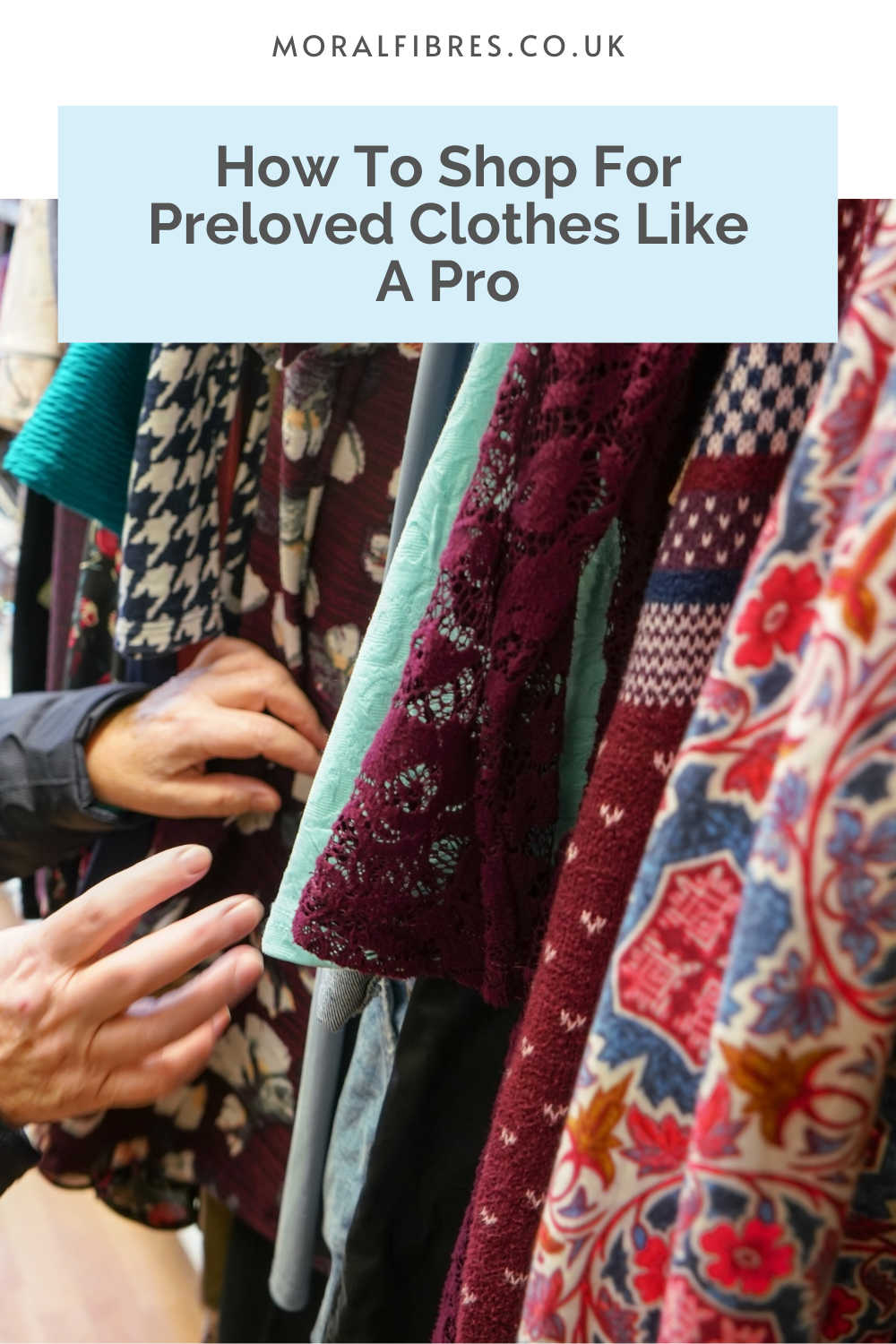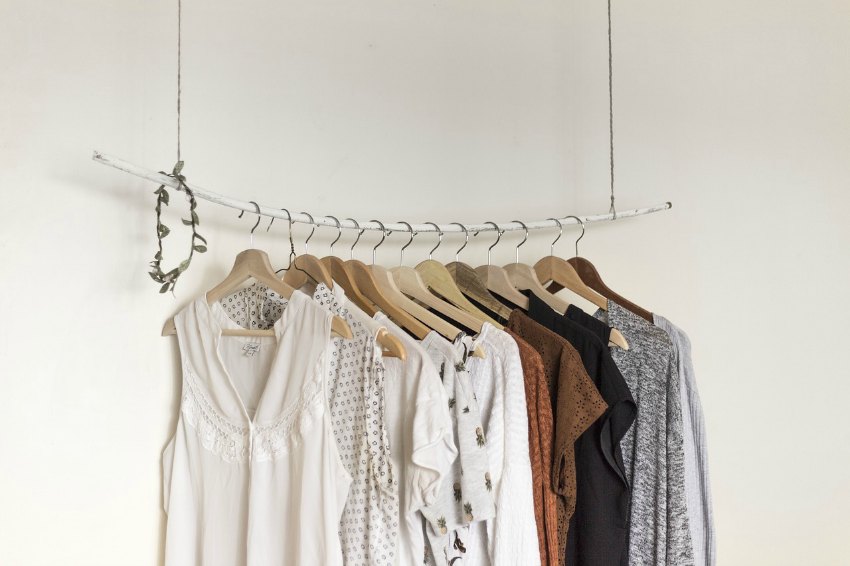How To Shop For Preloved Clothes Like A Pro
To support the running costs of Moral Fibres, this post contains affiliate links. This means Moral Fibres may earn a small commission, at no extra cost to readers, on items purchased through these links.
Shop for preloved clothes like a pro with these clever tips from ethical fashion expert Laura Strutt.
Laura Strutt, the author of the ethical fashion handbook Fix Your Fashion, is a font of information and inspiration when it comes to sustainable style.
Fix Your Fashion is full of activities and practical tips on how you can cut ties with unethical fashion practices. Laura also talks you through how to form new fashion habits that work for you – all without compromising your signature style.
The book covers heaps of useful topics. This includes motivational mindset changes to help you turn your back on fast fashion, as well as the trusted brands to try, and and questions to ask companies before you shop.
Laura also offers top tips on buying and selling secondhand clothes. Plus there’s some upcycling inspiration and mending techniques to make your clothes last longer. In short, it’s a practical handbook for anyone who wants to create a wardrobe that doesn’t cost the Earth.
Shopping secondhand is a great place to start making your wardrobe more ethical. As such, Laura is here with some seriously useful advice to help remove some of the barriers to getting started.
The Joy of Preloved Clothes
Secondhand clothing has (thankfully) had a considerable glow-up in recent years. It’s gone from something that we should be perhaps ashamed to admit to a celebrated thing. And I am here for that!
While growing up, secondhand clothing allowed me to experiment with my style to fit my modest teenage clothing budget.
I briefly had a Saturday job in a local charity shop. There was no greater joy than arriving early for my shift on a Saturday to see the selection of preloved clothes the weekday staff had set aside for me. The perks of being the only teenager on the work rota!
However, the joy I found in cast-off biker boots, Stevie Nicks style scarfs, grandad jumpers and baby cord flares was slightly marred by the bad rep that shopping at a charity shop had.
There seemed to be this idea that it wasn’t cool to buy secondhand clothes. That shopping secondhand meant you couldn’t afford to go to a ‘real shop’. That somehow the clothes weren’t as good.
With these ideas flying around, it is no wonder people would give secondhand clothing a wide berth.
Thankfully, not only did my time volunteering in a charity shop give me a very eclectic wardrobe. It also gave me an understanding of how clothes were processed for sale. Plus it introduced me to the concept of circular fashion, re-donating items when they fell out of rotation.
Not everyone has had such a positive experience with secondhand clothing. Maybe they may even feel a little uncomfortable about the stigma surrounding it. As embracing preloved clothing can seem a little daunting at first, here are some tips on leaping into a love affair with preloved clothes.
How To Shop For Preloved Clothes

If you’re not used to second-hand shopping, it can be overwhelming.
One of the main differences to high street browsing is that you never know what you’re going to find. If you’re after something specific, it can be frustrating. But it does make the purchase even sweeter when you finally find that perfect vintage jacket!
Here is how to get the very best when shopping for preloved and vintage clothes. Use the quick links to jump to a specific section of this post, or keep scrolling for the full article:
- Take Your Measurements
- Take Your Time
- Customise & Tailor
- Be Mindful Of Your Budget
- Visit Affluent Areas
- Shop Charity Shops Online
Take Your Measurements
The size on the tag is almost irrelevant. Of course, that number doesn’t define us, but this is even more true with vintage clothes, as they were made for different body forms using different measurements than clothes today.
Most vintage retailers will share the measurements of the items, so it’s a good idea to know your own body measurements. The key ones to check are full bust (around your back and over the fullest part of your bust), waist, hips and hem length.
For more tailored garments, you can get closer to your perfect fit by getting to know your inside leg, shoulder width and sleeve length.
Take Your Time
Don’t leave it until the last minute to look for the right vintage piece for a special occasion. This method of shopping is the opposite of fast fashion, so where you gain uniqueness, you may lose convenience (or the fallacy of it!). It might take longer to find preloved clothes that fit your requirements, style and budget, but that’s all part of the joy.
Customise & Tailor
Regular vintage clothing buyers get pieces altered so that they fit just right. Sizing can be hard to gauge, so you might want to size up when buying vintage online. Not only does this avoid the disappointment of a top that doesn’t fit, but it also gives you the option of taking it in and getting it fitted.
A well-fitted item will really steal the show. You may want to learn a few tips for getting handy with a needle and thread if you aren’t already. This is an excellent opportunity to learn how to take in seams, add darts and remove sleeves unless skyscraper shoulder pads are your thing!
Be Mindful Of Your Budget
It can be all too easy when shopping online to get caught up in the moment and throw in a high bid just before an auction finishes, paying over the odds. Before getting trigger-happy on the bidding button, check the going prices for similar items and set your budget.
Visit Affluent Areas
Pick the posh end of town when visiting charity shops. It might sound bizarre, but you often find that the quality of the garments that have been donated is quite high. You might even find some desirable labels in there!
Shop Charity Shops Online
Second-hand clothing isn’t limited to auction sites. If you have a favourite charity shop, be sure to check out their online charity shop fronts.
Familiar names like Oxfam, Cancer Research, The British Red Cross, Save The Children and the Royal Trinity Hospice can be found on ASOS Marketplace with 100 per cent of the proceeds returning to the nominated charities.
Thanks so much, Laura, for these seriously useful tips! If you have any other tips for shopping for preloved pieces, then as always, do share them with the Moral Fibres community in the comments below.
Found this post useful? Please consider buying me a virtual coffee to help support the site’s running costs.




